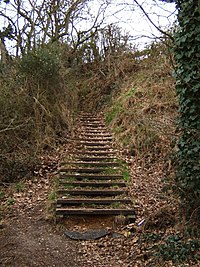Gryme's Dyke

Gryme’s Dyke is an Iron Age earthwork in Stanway, in Colchester, in Essex; the most westerly and the longest of a number of large linear earthwork dykes in the area. The Dyke is a Scheduled Ancient Monument,[1][2] and is believed to have formed part of an ancient ‘oppidum’, an earthen defensive ring around the Iron Age town.
- Location map: 51°52’55"N, 0°50’55"E
This is one of several ancient defensive earthworks in the southern and eastern counties bearing the name 'Grim's Ditch' and similar names.
It is believed that the dykes of Colchester were built in the late Iron Age to define and protect Colchester, an important town even in those ages. Some though can be dated to the early Roman period which has been suggested as the ages in which Gryme's Dyke was constructed: at this time the town was known to the Romans as Camulodunum. The more usual explanation is that it was built by King Cunobelin (Cymbeline) of the Trinovantes to defend his capital.
The dyke survives for much of its length as an upstanding earthwork. It was originally fronted by a ditch on its west side, now mostly infilled. its course can be traced for several miles, from New Bridge, north of the River Colne, to Stanway Green (scheduled as 'Gryme’s Dyke North and Middle') where the earthwork passes through a short dog-leg to the west before running on to the Roman River ('Gryme’s Dyke South').
See also
References
- ↑ National Heritage List 1019960: Gryme's Dyke Middle (Scheduled ancient monument entry)
- ↑ National Heritage List 1019992: Gryme's Dyke at Stanway Green (Scheduled ancient monument entry)
- Gryme's Dyke: Colchester Heritage